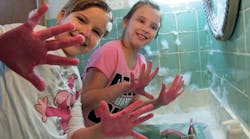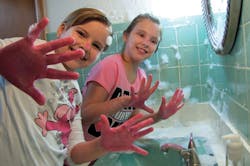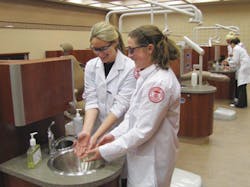Routine hand washing techniques helps instill confidence in battle against cross contamination
by Nicole Giesey, RDH, BSDH, MSPT
With the new super bug carbapenem-resistant Enterobacteriaceae (CRE) emerging, the Centers for Disease Control and Prevention (CDC) recommends hand washing as one of the top defense mechanisms available to minimize the spread of the bacteria to others (CDC, 2013).
Hand washing is one of the very first procedures learned in the first year of dental hygiene clinic. Hand washing is such a fundamental task learned as a child and is one of the most important habits to properly implement and share with others. The difference between the hand washing method I learned in kindergarten and the method I learned in hygiene school slightly varies in degree of detail.
My four year old and I wash our hands together. She turns on the water, splashes around a bit to soak the sink, floor and mirror yet she never seems to use soap until I gently remind her. Even when she uses soap, I feel that the sink is cleaner than her hands will ever be. Her method without intervention is far from perfect. Washing her hands means playtime to her and not infection control as I see it. It makes me think of how many people view hand washing as a nuisance rather than a very important role in disease prevention. Are people properly washing their hands or just splashing around?
I have always watched people and analyzed their infection control measures or lack thereof. For example, while watching a chef make a grilled chicken sandwich, I quickly gained an appreciation for eating at home. After grabbing a piece of raw chicken with his bare hands, I thought for sure he would wash his hands before proceeding. I quickly learned it was wishful thinking on my end. After a quick splash of water through his hands, forgetting to use soap, John grabbed lettuce, a tomato slice and a bun with his not-so-clean hands. All of the bacteria from the raw chicken most certainly not all washed off but rather is now infesting the lettuce, tomato and bun. Do I say something, or do I politely pay for a disease-bearing sandwich that I know I will not eat and just throw away. In this situation, I opted to pay and throw it away. Wasting food is certainly not my cup of tea, but I also do not fancy a night of hugging the toilet due to improper training of hand washing or just plain neglect and laziness.
I could easily write a book about the crazy infection control encounters I have come across in the last 17 years in the field. Everywhere you go, you see signs in public that say employees must wash their hands. It is so nice that employers want their employees to wash their hands, but are the employers assuming that their employees know how to properly wash their hands? Perhaps more training needs to be completed to ensure that proper hand washing is being done since it is such a crucial part of disease transmission as well as the theory of why you should wash your hands. Where is all of this leading? All of these stories lead to a proper technique and review of hand washing of course.
Routine, routine, and routine
I always discuss the importance of routines in the workplace for any procedure. Having a hand washing routine prior to the start of your work day, before and after patient care, and at the end of the day will decrease your risk of spreading disease to yourself and to the public you are treating by reducing the amount of microorganism and soil from your hand surface (CDC, 2013). Below are some suggestions on proper technique for not only your working day but for everyday living.
Antiseptic hand wash -- Typically, to start your day you would perform a good and thorough scrub up to your elbows with antimicrobial soap. This procedure should be performed three times for optimal effectiveness (Wilkins, 2013). When performing the antiseptic hand wash, remember to remove all jewelry and to use cool water. The CDC recommends all health-care workers to not wear artificial nails and to keep natural nails short and clean (CDC, 2013).
To begin with your antiseptic hand washing, make a nice lather starting with your hands and work your way to your forearms. To properly rinse one can also use the same direction that was used in washing by rinsing from the fingertips to the elbow keeping your fingertips pointed upward to not allow any water to run down the arm towards the fingers. This procedure should be repeated two more times for optimal effectiveness (Wilkins, 2013). Make sure when you dry your hands that you are not contaminating yourself. Now that you have thoroughly washed your hands and arms prior to the start of your day, you are ready to see patients. Once you are off to the races, routine hand washing and antiseptic hand rubs can carry you through the day.
Routine hand wash and hand sanitizers -- The routine hand wash is utilized before every gloving, after every glove removal, after you have touched something that is contaminated, when you see that your hands are soiled, and before you leave your treatment room.
The one tip seen in every article about hand washing is to use not antimicrobial soap with the routine hand wash but nonantimicrobial soap or just plain soap. In 1975 and 1988, formal guidelines about when to use nonantibacterial and antibacterial soaps were published by the CDC.
The routine hand wash method is fairly easy and requires little thought except for just doing it. Be sure when washing your hands that you are using cool water. This theory goes back to the anatomy and physiology courses when the vasodilatation theory was discussed. If you are using hot or warmer water, your pores on your skin will vasodilate, thus allowing the floodgates of bacteria to invade your pores and make a nice cozy home. The routine hand washing method is ideally recommended to last about 15 to 30 seconds (CDC, 2013).
Another interesting point that should be made is in the CDC diagram that illustrates a technique on how to wash your hands; it is shown to turn off the water with a paper towel thus preventing contamination from the faucet. This is so instrumental.
Plus, in almost every instance where you would be washing your hands, there is a waste basket for throwing away your paper towel. I will actually add to the CDC recommendation and add a step. I always dispense a couple of paper towels first and tuck it under my forearm prior to washing. I always do this step when washing in public. This prevents contamination from the dispenser. If someone just splashed around and did not properly wash their hands but touched the paper towel dispenser with contaminated hands their bacteria would just be breeding on the dispenser handle. You can feel confident in drying your hands with one towel and turning off the water with the other. While in practice, I typically always use a free standing paper dispenser where the paper towel is not dispensed with a lever but is exposed freely eliminating the lever contamination issue. If you are lucky to work in a setting that has an antiseptic hand rub available, you can utilize this method if your hands are not visibly soiled.
Hand sanitizers are seen virtually everywhere. Even the gas stations have them to use before and after you pump gas. If you ever go a hospital, they are in every patient room and every hallway. The promotion of hand sanitizing and hand cleaning is such a huge issue right now especially during flu and cold season.
The method is easy to use. To use a hand sanitizer simply squirt into the palm of your hand and rub thoroughly your entire hand surface, fingers, and wrists for 20 seconds, according to the Mayo Clinic, 2012. The Mayo clinic also recommends that the hand sanitizer should have at least 60% alcohol in it. Hand sanitizers are ideal in that it is so portable and does not need a sink to use it. One must be careful to not overuse hand sanitizer or use it solely to ensure that rinsing from hand washing does happen to rinse off the bacteria at some point.
These methods of hand washing and sanitizing are just one step in the infection control battle. What else are you touching with your gloves? Cross contamination while wearing gloves needs to be analyzed. Touching papers, keyboards, floss holders, pens, mouse controllers, patient lead aprons, and X-ray buttons to name a few are potential targets if one is not using proper barriers and infection control. By touching any contaminated item in our operatory or office and not following up with a hand wash or hand sanitizer will lead into disease transmission.
Our patients assume and hope that we are taking proper infection control measures. Hand washing is a given in their minds. They are also assuming that since we wear gloves they are protected. Help ensure their thinking by hand washing in front of them if possible prior to the start of the appointment. We are in our field of prevention for a reason. We all love to help others; it is in our nature. By instilling a routine of good hand washing, you can be a warrior in disease prevention. Perhaps you can even inspire others to take after you. RDH
HELPFUL WEBSITES
http://www.cdc.gov/handhygiene/
http://www.osha.gov/SLTC/etools/hospital/hazards/infection/infection.html
http://www.mayoclinic.com/health/hand-washing/HQ00407
REFERENCES
Center for Disease Control and Prevention. (2013). Handwashing in the Healthcare setting. Retrieved from http://www.cdc.gov/handhygiene/
Mayo Foundation for Medical Education and Research. (2012). Handwashing. http://www.mayoclinic.com/health/hand-washing/HQ00407
Wilkins EM. (2013). Clinical practice of the dental hygienist (11th ed). Baltimore: Lippincott Williams & Wilkins, a Wolters Kluwer business.
Nicole Giesey, RDH, BSDH, MSPTE, practices clinically part time, is a writer, and an adjunct dental hygiene clinical instructor at Youngstown State University. She enjoys researching, writing, and creating fun puzzles about dental hygiene topics. Nicole can be reached at [email protected].
Past RDH Issues








